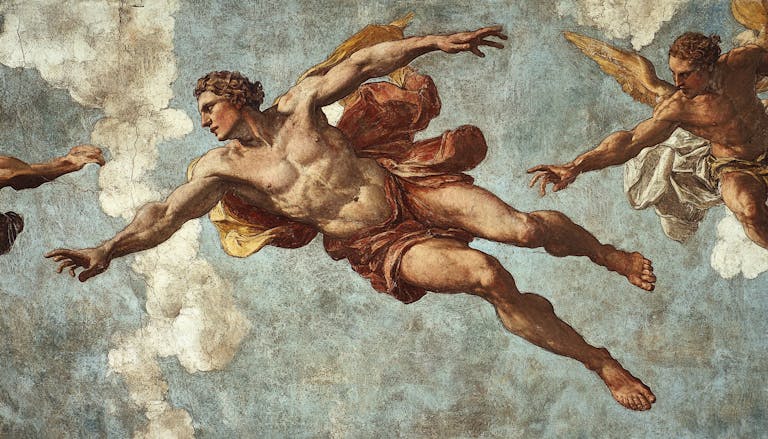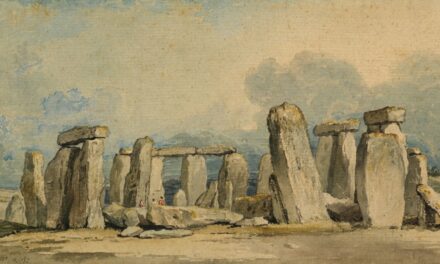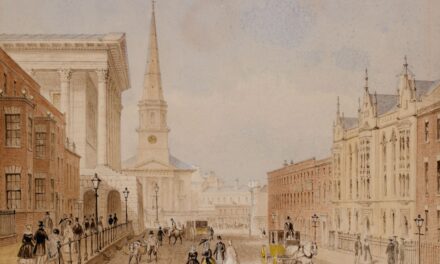Mannerism art emerged in the late Renaissance period, circa the 16th century, and is characterised by its intentional deviation from classical principles of balance, harmony and idealised beauty. Mannerist artists endeavoured to create works that were more emotionally charged, featuring exaggerated proportions, elongated figures and a sense of instability and tension. The term ‘Mannerism’ derives from the Italian word ‘maniera’, meaning style or manner, reflecting the self-conscious and artificial nature of the art movement.
Mannerism is often regarded as a reaction against the perfection and rationality of High Renaissance art. Artists deliberately distorted and exaggerated forms to create a sense of unease and ambiguity. This departure from classical ideals of beauty and harmony led to a more subjective and expressive approach to art, emphasising individual creativity and imagination.
Mannerist art is notable for its complex compositions, unusual spatial arrangements and a heightened sense of drama and emotion. It is frequently characterised by the use of elongated figures, contorted poses and a sense of artificiality that distinguishes it from the naturalism of earlier Renaissance art.
Summary
- Mannerism art is a style that emerged in the late Renaissance period, known for its exaggerated and elongated figures, complex compositions, and use of unnatural colours.
- Mannerism art originated in Italy in the early 16th century as a reaction against the harmony and balance of the High Renaissance, and it spread to other parts of Europe in the following decades.
- Key characteristics of mannerism art include distorted proportions, ambiguous space, and a focus on emotional intensity and theatricality.
- Notable mannerist artists include El Greco, Parmigianino, and Jacopo da Pontormo, who were known for their unique and unconventional artistic styles.
- Mannerism art had a significant impact on architecture, with its influence seen in the use of complex and irregular forms, as well as the incorporation of decorative elements and exaggerated details.
The Origins of Mannerism Art
The origins of Mannerism art can be traced back to the work of artists such as Michelangelo and Raphael, who were key figures in the High Renaissance. As the Renaissance progressed, artists began to experiment with new forms of expression and to push the boundaries of traditional artistic conventions. This led to the development of a more self-conscious and artificial style that came to be known as Mannerism.
One of the key factors that contributed to the rise of Mannerism was the changing cultural and political landscape of 16th century Italy. The period was marked by social and religious upheaval, as well as the rise of new intellectual and artistic ideas. This climate of uncertainty and instability provided fertile ground for artists to explore new ways of representing the world around them.
As a result, Mannerist art emerged as a reaction against the rationality and order of the High Renaissance, with artists seeking to create works that were more emotionally charged and intellectually stimulating.
Key Characteristics of Mannerism Art
Mannerism art is characterized by several key features that set it apart from earlier Renaissance styles. One of the most distinctive characteristics of Mannerist art is its use of elongated and exaggerated forms. Figures in Mannerist paintings and sculptures are often depicted with elongated limbs, torsos, and necks, giving them a sense of otherworldly elegance and grace.
This deliberate distortion of proportions creates a sense of instability and tension, as well as a heightened emotional intensity. Another key characteristic of Mannerism art is its complex compositions and spatial arrangements. Mannerist artists often created works with crowded and convoluted compositions, with figures arranged in unusual and dynamic poses.
This use of complex spatial arrangements adds to the sense of drama and unease that is characteristic of Mannerist art. In addition, Mannerist artists often employed a heightened sense of artificiality in their works, using exaggerated colours, lighting, and perspective to create a sense of theatricality and illusion. Mannerist art is also known for its use of ambiguous and enigmatic imagery.
Artists often incorporated symbolic elements and allegorical references into their works, creating layers of meaning that invited viewers to interpret and engage with the art on a deeper level. This use of symbolism added to the intellectual complexity of Mannerist art, as well as its sense of mystery and intrigue.
Notable Mannerist Artists
Several notable artists were key figures in the development of Mannerism art. One of the most influential Mannerist artists was Parmigianino, whose work is characterized by its elegant and elongated figures, as well as its use of complex compositions and enigmatic symbolism. Another important figure in the Mannerist movement was Jacopo da Pontormo, whose paintings are known for their emotional intensity and dynamic spatial arrangements.
Another significant Mannerist artist was Rosso Fiorentino, who was known for his use of vibrant colours and dramatic lighting effects. His work often featured exaggerated forms and contorted poses, adding to the sense of emotional intensity that is characteristic of Mannerist art. Another key figure in the development of Mannerism was Agnolo Bronzino, whose paintings are known for their refined elegance and enigmatic symbolism.
Mannerism Art in Architecture
Mannerism art also had a significant impact on architecture during the 16th century. Architects began to experiment with new forms and spatial arrangements, creating buildings that were more dynamic and expressive than those of the High Renaissance. One of the key characteristics of Mannerist architecture is its use of complex and irregular forms, as well as its emphasis on decorative elements such as elaborate mouldings, sculptural details, and ornate facades.
Mannerist architects also sought to create buildings that were more emotionally charged and intellectually stimulating than those of the High Renaissance. They used exaggerated proportions, unusual spatial arrangements, and a heightened sense of drama to create a sense of unease and ambiguity in their designs. This departure from the classical principles of balance and harmony led to a more subjective and expressive approach to architecture, with a focus on individual creativity and imagination.
One notable example of Mannerist architecture is the Palazzo del Te in Mantua, Italy, which was designed by the architect Giulio Romano. The building features a series of interconnected courtyards and loggias, as well as elaborate decorative elements such as frescoes, stucco work, and sculptural details. The Palazzo del Te is known for its dynamic spatial arrangements and its use of exaggerated forms, adding to the sense of drama and emotional intensity that is characteristic of Mannerist architecture.
Mannerism Art’s Influence on Later Movements
Mannerism art had a significant influence on later artistic movements, particularly Baroque art. The exaggerated forms, dynamic compositions, and heightened emotional intensity that are characteristic of Mannerism can be seen as precursors to the dramatic and theatrical style of Baroque art. Baroque artists such as Caravaggio and Gian Lorenzo Bernini drew inspiration from the emotional intensity and expressive qualities of Mannerist art, incorporating these elements into their own work.
Mannerism also had an impact on the development of academic art in the 17th century. The artificiality and self-consciousness that are characteristic of Mannerist art can be seen as precursors to the emphasis on technical skill and formal conventions that became central to academic art during this period. In addition, the use of enigmatic symbolism in Mannerist art influenced later artists such as the Surrealists, who sought to create works that were open to multiple interpretations and engaged with the subconscious mind.
The Legacy of Mannerism Art
The legacy of Mannerism art can be seen in its lasting impact on artistic expression and creativity. The deliberate departure from classical ideals of beauty and harmony paved the way for new forms of artistic experimentation and innovation. The emphasis on emotional intensity, enigmatic symbolism, and subjective expression in Mannerist art laid the groundwork for later artistic movements such as Baroque art, academic art, and Surrealism.
Mannerism also challenged traditional artistic conventions and paved the way for a more individualistic approach to art-making. The focus on personal creativity and imagination in Mannerist art encouraged artists to explore new ways of representing the world around them, leading to a greater diversity of artistic styles and expressions. In this way, Mannerism art can be seen as a precursor to the modern emphasis on individuality and originality in artistic practice.
In conclusion, Mannerism art emerged as a reaction against the rationality and order of the High Renaissance, with artists seeking to create works that were more emotionally charged, intellectually stimulating, and subjectively expressive. The deliberate distortion of forms, complex compositions, enigmatic symbolism, and heightened artificiality are key characteristics that set Mannerism apart from earlier Renaissance styles. The legacy of Mannerism can be seen in its lasting impact on later artistic movements such as Baroque art, academic art, and Surrealism, as well as its role in challenging traditional artistic conventions and paving the way for a more individualistic approach to art-making.
If you are interested in learning more about different art movements, you may want to check out an article on Post-Impressionism. This movement, which emerged in the late 19th century, was a reaction against the naturalism of Impressionism and focused on the use of colour and form to express emotion. You can read more about it here.
FAQs
What is Mannerism art?
Mannerism art is a style that emerged in the late Renaissance period, around the 16th century. It is characterized by a departure from the harmony and balance of the High Renaissance, featuring exaggerated proportions, elongated figures, and a sense of artificiality.
What are the key characteristics of Mannerism art?
Key characteristics of Mannerism art include elongated proportions, exaggerated poses, unusual spatial relationships, and a departure from naturalism. Artists often used complex compositions and distorted perspectives to create a sense of unease or tension in their works.
Which artists are associated with Mannerism art?
Prominent artists associated with Mannerism art include El Greco, Parmigianino, Jacopo da Pontormo, and Agnolo Bronzino. These artists were known for their unconventional and highly stylized approach to art, which set them apart from the more classical traditions of the Renaissance.
What influenced the development of Mannerism art?
Mannerism art was influenced by the social and political upheaval of the time, as well as the changing religious and philosophical landscape. It also drew inspiration from the works of earlier Renaissance artists, but sought to push the boundaries of traditional artistic conventions.
How did Mannerism art differ from the High Renaissance?
Mannerism art differed from the High Renaissance in its rejection of the classical ideals of balance, harmony, and naturalism. Instead, Mannerist artists embraced distortion, exaggeration, and a sense of artificiality in their works, creating a more emotionally charged and intellectually complex style.




